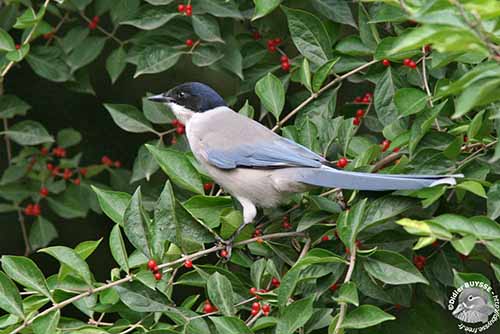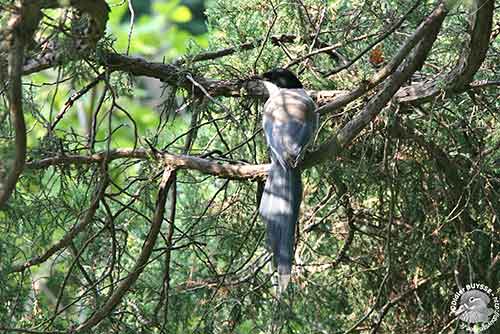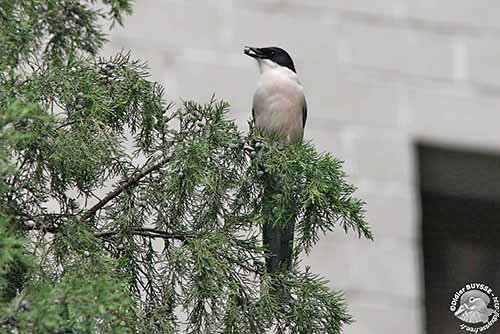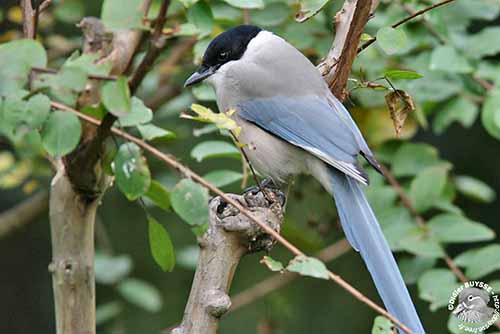
Fr: Pie bleue à calotte noire
Ang: Asian Azure-winged Magpie
All: Azurelster
Esp: Rabilargo Asiático
Ita: Gazza aliazzurre
Nd: Aziatische Blauwe Ekster
Sd: östlig blåskata
Photographer:
Didier Buysse
Vision d’Oiseaux
Text by Nicole Bouglouan
Sources:
HANDBOOK OF THE BIRDS OF THE WORLD Vol 14 by Josep del Hoyo-Andrew Elliot-David Christie - Lynx Edicions – ISBN: 9788496553507
CORBEAUX ET GEAIS: Guide des Corbeaux, Geais et Pies du Monde – Steve Madge, Hilary Burn – Editeur : Vigot (18/04/1996) – ISBN 10: 2711412687 – ISBN 13 : 978-2711412686
The Royal Society
Inferring the phylogeny of disjunct populations of the azure–winged magpie Cyanopica cyanus from mitochondrial control region sequences by Koon Wah Fok, Christopher M. Wade, David T. Parkin
Synchronic east–west divergence in azure-winged magpies (Cyanopica cyanus) and magpies (Pica pica)
A. Kryukov, M. A. Iwasa, R. Kakizawa, H. Suzuki, W. Pinsker and E. Haring
COOPERATIVE BREEDING IN AZURE-WINGED MAGPIES, CYANOPICA CYANA, LIVING IN A REGION OF HEAVY SNOWFALL
By SHIGEMOTO KOMEDA, SATOSHI YAMAGISHI, AND MASAHIRO FUJIOKA
Department of Biology, Faculty of Science, Osaka City University, Sumiyoshi-ku, Osaka 558, Japan
Welcome to WhoZoo (Jill Foley)
Asian Azure-winged Magpie
Cyanopica cyanus
Passeriformes Order – Corvidae Family
INTRODUCTION:
The Asian Azure-winged Magpie is today treated as full species with seven subspecies spread throughout the wide Eastern range.
But formerly, C. cyanus and C. cooki were treated as conspecific.
Following several studies between the seven subspecies of C. cyanus and C. cooki, including DNA and morphological analyses, it appears that the morphological data are in accordance with the results of genetic analyses. The difference between western and eastern birds is much higher than among the subspecies of the Asian populations.
This result rejects the idea of a recent introduction of Asian Azure-winged Magpies into Europe. The Iberian Magpie is probably native to Iberia and not the result of an introduction from Asia.
There is a great homogeneity among the Asian subspecies, except the Japanese race C. japonica, which is fairly distinct as a consequence or geographic isolation on the Japanese islands.
DESCRIPTION OF THE BIRD:
Biometrics:
Length: 36-38 cm
Weight: M: 80-118 g – F: 76-112 g
The adult of nominate race has dull greyish upperparts (paler and browner towards East). The upperwing is blue with black, white-edged primaries forming a distinct panel, and notched tips. The long, graduated tail is blue with brownish feather shafts, and the central rectrices have broad whitish tips.
On the underparts, chin and throat are pure white, whereas rest of the underparts are whitish with sandy-grey tinge.
On the head, we can see a black hood extending down below the eye, ear-covert and nape (where the feathers are slightly ruffled). This black hood bordered by narrow pale collar on the lower nape, contrasts strongly with the white malar area.
The black bill is relatively small and pointed. The eyes are dark brown to blackish. Legs and feet are black.

Male and female are similar.
The juvenile resembles adults, but it has browner hood and pale fringes to crown feathers. On the upperwing, the wing-coverts show sandy fringes and the greater coverts are tipped white, forming a narrow wingbar. The pale tips of the tail are indistinct.
SUBSPECIES AND RANGE:
The Asian Azure-winged Magpie has 7 recognized subspecies.
C.c. cyanus (described above) occurs in NW Mongolia, E across Transbaikalia, and S Yakutia to SE Russia and S to NE China.
C.c. japonica is found in C Japan. This race is smaller and darker, and wings and tail are brighter blue.
C.c. stegmanni occurs in NE China. This one has darker and greyer body colour than nominate.
C.c. koreensis is found in the Korean Peninsula. This race is browner above and whiter below.
C.c. kansuensis occurs in NC China. This one is greyish above and creamy-white below. It has the smallest bill of all races.
C.c. interposita is found in N China. This race is a grey form, darker than “stegmanni”.
C.c. swinhoei occurs in EC and E China. This one is browner than previous.
HABITAT:
The Asian Azure-winged Magpie tends to avoid dense forests and mountain slopes, but it usually frequents lowland thickets with Salix and Prunus and tall deciduous trees on riverine islands.
It can be seen in urban parks and gardens, and often occurs in wooded farmland and orchards, and mixed woodland. The species is visible up to 1600 metres of elevation.
CALLS AND SONGS: SOUNDS BY XENO-CANTO
The Asian Azure-winged Magpie gives a shivering, rising “screeep”, a typical sound used as contact call between birds moving among the vegetation.
It also uses a sharp chatter, a whistled “we-we-we-u”, and a piercing “krarah” as alarm call, usually followed by metallic “clink”.
Actually, these calls are very similar to those of C. cooki.

BEHAVIOUR IN THE WILD:
The Asian Azure-winged Magpie is gregarious and often foraging in small groups hidden in the foliage at treetops. During the breeding season, they occur in family groups which later join larger flocks of up to 100 individuals in China. During winter, these flocks sleep communally at nightime roosts.
They forage in trees and feed on insects and their larvae, spiders, fruits and berries and nuts according to the season. The Asian Azure-winged Magpie may sometimes hang upside down while searching for invertebrates and fruits. It also comes to the ground and hops with raised tail while turning over the leaf litter or searching in bark or tree holes. It also takes carrion.
This species tends to store food items such as acorns and seeds, usually in loose soil. In urban areas, they often raid rubbish dumps and litter bins.
The Asian Azure-winged Magpie breeds in loose colonies with usually one nest per tree, but some colonies may include up to 70 nests. The pairs appear to be monogamous and remain together within the flocks.
Pairs have helpers, probably young birds from the previous year. They help to feed the chicks and often take part in nest building.
The Asian Azure-winged Magpie is mostly resident. In Japan, it may perform short altitudinal movements of 1-2 kilometres after heavy snowfall. The populations of Ussuriland disperse in winter and reaches open country or inshore islands.
This species has fast flight.

REPRODUCTION OF THIS SPECIES:
The laying occurs in May-June, with peak in late May in Ussuriland and Japan.
Within the loose colonies, the nests are 15-20 metres apart, usually one per tree. The female builds the nest with materials provided by both male and helpers. She works during 10-18 days. The nest is made with twigs and rootlets, and the deep cup is lined with soft vegetation and animal hair. It is placed at ground level or up to 2 metres above the ground, occasionally at 15 metres high, and often in tree hollow.
The female lays 5-7 buff to pale green eggs with dark spots. She incubates during 15 days while the male feeds her at nest. Helpers often take part in feeding chicks and later, the female feeds them too as they are growing up. They fledge 16-19 days after hatching.
The nest is often parasitized by the Common Cuckoo.
PROTECTION / THREATS / STATUS:
The Asian Azure-winged Magpie is locally common and even increasing in most part of its Asian range. Some localized extinctions are probably due to competition with the introduced Pica pica.
This species has wide range and the population is increasing, and currently, the Asian Azure-winged Magpie is evaluated as Least Concern.
